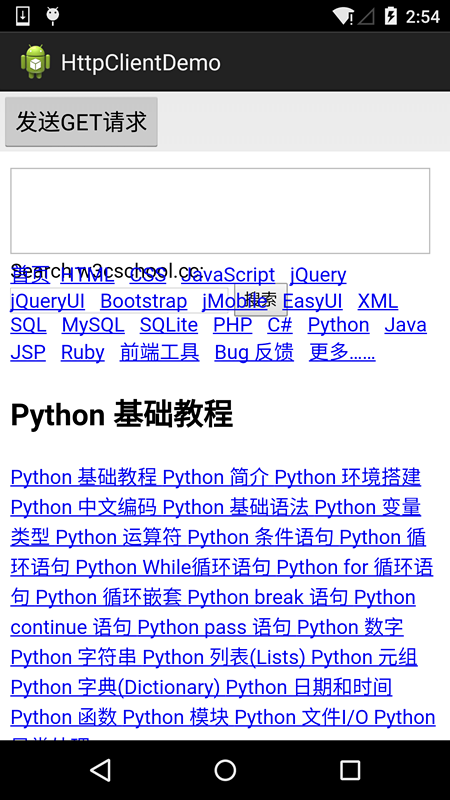本节引言:
在上一节中我们对HttpURLConnection进行了学习,本节到第二种方式:HttpClient,尽管被Google弃用了,但是我们我们平时也可以拿HttpClient来抓下包,配合Jsoup解析网页效果更佳!HttpClient用于接收/发送Http请求/响应,但不缓存服务器响应,不执行HTML页面潜入的JS代码,不会对页面内容进行任何解析,处理!开始本节内容!
1.HttpClient使用流程
基本流程:
2.HttpClient使用示例
1)使用HttpClient发送GET请求
直接贴下简单的发送Get请求的代码:
public class MainActivity extends Activity implements OnClickListener { private Button btnGet; private WebView wView; public static final int SHOW_DATA = 0X123; private String detail = ""; private Handler handler = new Handler() { public void handleMessage(Message msg) { if(msg.what == SHOW_DATA) { wView.loadDataWithBaseURL("",detail, "text/html","UTF-8",""); } }; }; @Override protected void onCreate(Bundle savedInstanceState) { super.onCreate(savedInstanceState); setContentView(R.layout.activity_main); initView(); setView(); } private void initView() { btnGet = (Button) findViewById(R.id.btnGet); wView = (WebView) findViewById(R.id.wView); } private void setView() { btnGet.setOnClickListener(this); wView.getSettings().setDomStorageEnabled(true); } @Override public void onClick(View v) { if (v.getId() == R.id.btnGet) { GetByHttpClient(); } } private void GetByHttpClient() { new Thread() { public void run() { try { HttpClient httpClient = new DefaultHttpClient(); HttpGet httpGet = new HttpGet("http://www.w3cschool.cc/python/python-tutorial.html"); HttpResponse httpResponse = httpClient.execute(httpGet); if (httpResponse.getStatusLine().getStatusCode() == 200) { HttpEntity entity = httpResponse.getEntity(); detail = EntityUtils.toString(entity, "utf-8"); handler.sendEmptyMessage(SHOW_DATA); } } catch (Exception e) { e.printStackTrace(); } }; }.start(); }}运行截图

另外,如果是带有参数的GET请求的话,我们可以将参数放到一个List集合中,再对参数进行URL编码,最后和URL拼接下就好了:
List<BasicNameValuePair> params = new LinkedList<BasicNameValuePair>(); params.add(new BasicNameValuePair("user", "猪小弟")); params.add(new BasicNameValuePair("pawd", "123"));String param = URLEncodedUtils.format(params, "UTF-8"); HttpGet httpGet = new HttpGet("http://www.baidu.com"+"?"+param);2)使用HttpClient发送POST请求
POST请求比GET稍微复杂一点,创建完HttpPost对象后,通过NameValuePair集合来存储等待提交的参数,并将参数传递到UrlEncodedFormEntity中,最后调用setEntity(entity)完成,HttpClient.execute(HttpPost)即可;这里就不写例子了,暂时没找到Post的网站,又不想自己写个Servlet,So,直接贴核心代码吧~
核心代码:
private void PostByHttpClient(final String url){ new Thread() { public void run() { try{ HttpClient httpClient = new DefaultHttpClient(); HttpPost httpPost = new HttpPost(url); List<NameValuePair> params = new ArrayList<NameValuePair>(); params.add(new BasicNameValuePair("user", "猪大哥")); params.add(new BasicNameValuePair("pawd", "123")); UrlEncodedFormEntity entity = new UrlEncodedFormEntity(params,"UTF-8"); httpPost.setEntity(entity); HttpResponse httpResponse = httpClient.execute(httpPost); if (httpResponse.getStatusLine().getStatusCode() == 200) { HttpEntity entity2 = httpResponse.getEntity(); detail = EntityUtils.toString(entity2, "utf-8"); handler.sendEmptyMessage(SHOW_DATA); } }catch(Exception e){e.printStackTrace();} }; }.start();}3.HttpClient抓数据示例(教务系统数据抓取)
其实关于HttpClient的例子有很多,比如笔者曾经用它来抓学校教务系统上学生的课程表:这就涉及到Cookie,模拟登陆的东西,说到抓数据(爬虫),一般我们是搭配着JSoup来解析抓到数据的,有兴趣可以自己查阅相关资料,这里贴下笔者毕设app里获取网页部分的关键代码!大家可以体会下:
HttpClient可以通过下述代码获取与设置Cookie:HttpResponse loginResponse = new DefaultHttpClient().execute(getLogin);获得Cookie:cookie = loginResponse.getFirstHeader("Set-Cookie").getValue();请求时带上Cookie:httpPost.setHeader("Cookie", cookie);
//获得链接,模拟登录的实现:public int getConnect(String user, String key) throws Exception { // 先发送get请求 获取cookie值和__ViewState值 HttpGet getLogin = new HttpGet(true_url); // 第一步:主要的HTML: String loginhtml = ""; HttpResponse loginResponse = new DefaultHttpClient().execute(getLogin); if (loginResponse.getStatusLine().getStatusCode() == 200) { HttpEntity entity = loginResponse.getEntity(); loginhtml = EntityUtils.toString(entity); // 获取响应的cookie值 cookie = loginResponse.getFirstHeader("Set-Cookie").getValue(); System.out.println("cookie= " + cookie); } // 第二步:模拟登录 // 发送Post请求,禁止重定向 HttpPost httpPost = new HttpPost(true_url); httpPost.getParams().setParameter(ClientPNames.HANDLE_REDIRECTS, false); // 设置Post提交的头信息的参数 httpPost.setHeader("User-Agent", "Mozilla/5.0 (Windows NT 6.3; WOW64; Trident/7.0; rv:11.0) like Gecko"); httpPost.setHeader("Referer", true_url); httpPost.setHeader("Cookie", cookie); // 设置请求数据 List<NameValuePair> params = new ArrayList<NameValuePair>(); params.add(new BasicNameValuePair("__VIEWSTATE", getViewState(loginhtml)));// __VIEWSTATE参数,如果变化可以动态抓取获取 params.add(new BasicNameValuePair("Button1", "")); params.add(new BasicNameValuePair("hidPdrs", "")); params.add(new BasicNameValuePair("hidsc", "")); params.add(new BasicNameValuePair("lbLanguage", "")); params.add(new BasicNameValuePair("RadioButtonList1", "%D1%A7%C9%FA")); params.add(new BasicNameValuePair("txtUserName", user)); params.add(new BasicNameValuePair("TextBox2", key)); params.add(new BasicNameValuePair("txtSecretCode", "")); // ( ╯□╰ )逗比正方,竟然不需要验证码 // 设置编码方式,响应请求,获取响应状态码: httpPost.setEntity(new UrlEncodedFormEntity(params, "gb2312")); HttpResponse response = new DefaultHttpClient().execute(httpPost); int Status = response.getStatusLine().getStatusCode(); if(Status == 200)return Status; System.out.println("Status= " + Status); // 重定向状态码为302 if (Status == 302 || Status == 301) { // 获取头部信息中Location的值 location = response.getFirstHeader("Location").getValue(); System.out.println(location); // 第三步:获取管理信息的主页面 // Get请求 HttpGet httpGet = new HttpGet(ip_url + location);// 带上location地址访问 httpGet.setHeader("Referer", true_url); httpGet.setHeader("Cookie", cookie); // 主页的html mainhtml = ""; HttpResponse httpResponseget = new DefaultHttpClient() .execute(httpGet); if (httpResponseget.getStatusLine().getStatusCode() == 200) { HttpEntity entity = httpResponseget.getEntity(); mainhtml = EntityUtils.toString(entity); } } return Status;}4.使用HttpPut发送Put请求
示例代码如下:
public static int PutActCode(String actCode, String licPlate, Context mContext) { int resp = 0; String cookie = (String) SPUtils.get(mContext, "session", ""); HttpPut httpPut = new HttpPut(PUTACKCODE_URL); httpPut.setHeader("Cookie", cookie); try { List<NameValuePair> params = new ArrayList<NameValuePair>(); params.add(new BasicNameValuePair("activation_code", actCode)); params.add(new BasicNameValuePair("license_plate", licPlate)); httpPut.setEntity(new UrlEncodedFormEntity(params, "UTF-8")); HttpResponse course_response = new DefaultHttpClient().execute(httpPut); if (course_response.getStatusLine().getStatusCode() == 200) { HttpEntity entity2 = course_response.getEntity(); JSONObject jObject = new JSONObject(EntityUtils.toString(entity2)); resp = Integer.parseInt(jObject.getString("status_code")); return resp; } } catch (Exception e) { e.printStackTrace(); } return resp;}本节小结:
好的,本节关于Android HTTP的第二种请求方式:HttpClient就到这里,下节开始我们来学习XML以及Json的解析,本节就到这里,谢谢~

